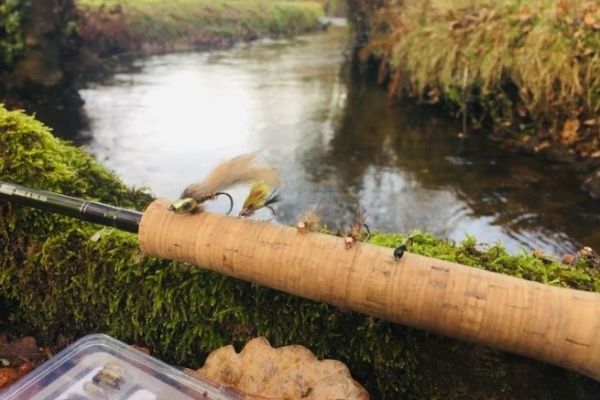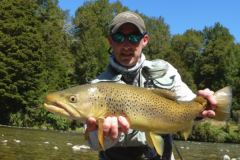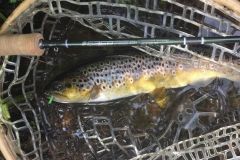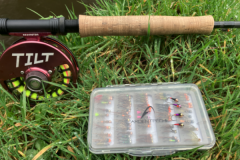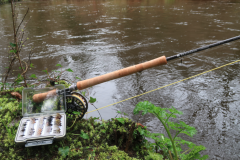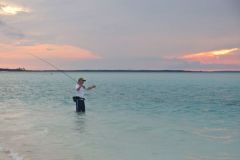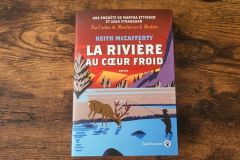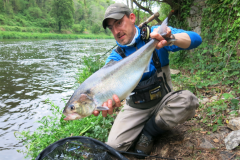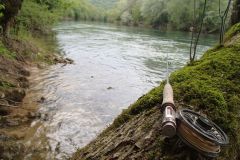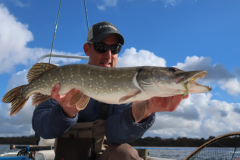1- Flash back pheasant tail
A simple but very effective variant of the pheasant tail, which sometimes makes all the difference.
I discovered it a long time ago in a fly shop in Montana, and it's never left my boxes. Close to the original model, its success is only enhanced by that little touch of "flashy". It will allow you to catch even more trout on certain days!
Assembly sheet
Hook C124 BL size 10.
UTC 70 black mounting silk.
Place a ball here in tungsten here in copper in 3.3.
Use the mounting silk to cover the shank and block the tail with 5/6 pheasant tail fibers. Then secure a fine copper wire and 4 herls of pheasant tail.
Form the body with the pheasant, then hoop with the copper. Secure with two strands of kristal flash or one strand of lateral scale pearl. Then tuft 7/8 strands of pheasant. Form a natural hare dubbing thorax. Cover with pheasant and flash. Secure and tie the final knot. Ruffle the dubbing on the thoras to create more life.
Tips and tricks
Can be used as a classic pheasant tail. Can be fitted with beads of different weights and colors. It's always interesting to have variations on this timeless model.
Can be mounted on jig hooks.
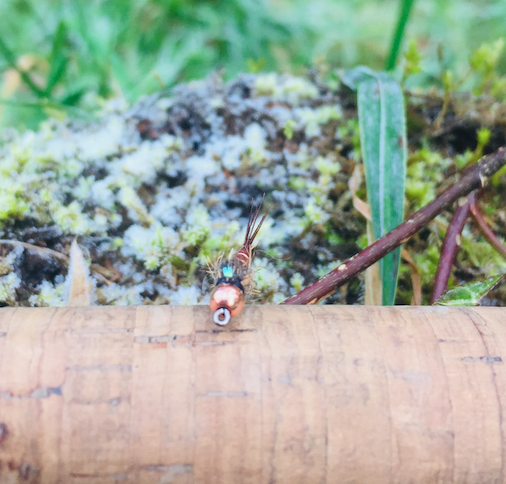
2- ORL pearl
Also a variation on the ENT with a crystal flash pearl hoop to great effect. I think it emits colors close to the emerging nymph that trout are so fond of. It can be seen from afar without being too "blinb bling". Another nymph always to hand in my boxes.
Assembly sheet
TMC 100 hook in sizes 18 to 10, shown here in size 12.
UTC 70 black mounting silk.
Place a brass or tungsten copper ball.
Bring the mounting line to the bend and block a clump of 5/6 pheasant strands, passing once behind to keep them in line or slightly inclined.
Then block with krystal flash pearl thread. Make a tapered underbody with the mounting silk.
Put pitch on the mounting wire, then natural ENT dubbing.
Wrap the dubbing loosely, then hoop with the krystal flash thread.
Final knot. Ruffle the dubbing.
Tips and tricks
Sometimes it's important to keep things simple and minimalist. This ORL model is a variation with a flash pearl krystal hoop instead of traditional copper wire (gold, silver). The shine really appeals to fish. I also use it to rig my ORLs dry. Available in different sizes (20 to 10) and with different ball densities. Also works well with an orange bead or orange cheeks behind the bead.
Small animations on the presumed position can, on certain days, trigger more touches, but it usually takes inert, as it lives in the water thanks to the highly mobile and realistic hare hairs.
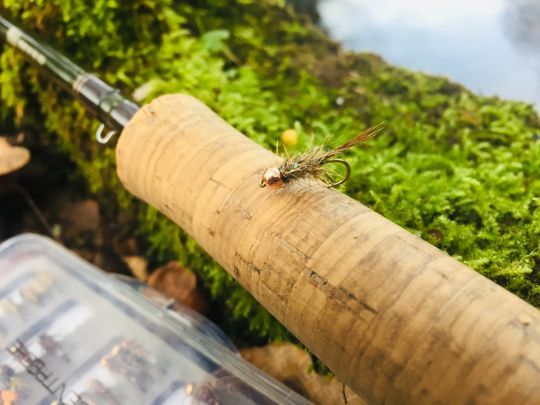
3- Perdi-quill
A nymph that I started to mount a few years ago, reminiscent of a "chiro" but also of a mayfly. The small orange thorax arouses the curiosity of trout and grayling alike.
A rather discreet nymph, however, and very catchy even on educated fish.
Assembly sheet
Hook C124 Bl size 10.
UTC 70 mounting wire, black.
Place a brass or tungsten ball in 2.8 black.
Then place a small orange bead (for the bracelet). Attach a tuft of grey cop pardo. Form a regular, conical body. Attach a natural peacock quill to the bend (keeping the black edge on the left side). Wrap around the quill and block at the pearl. Final knot.
Apply a drop of black varnish to the pearl and bead. Allow to dry thoroughly, then cover the body and thorax with thin UV resin. Freeze. Finished fly.
Tips and tricks
An original little all-purpose nymph with a touch of orange that attracts fish from afar. Can be used on its own or on a jig. Also works in a tank on a chiro train. Green pearls (water worms) or olive pearls are also very attractive, but hard to find.
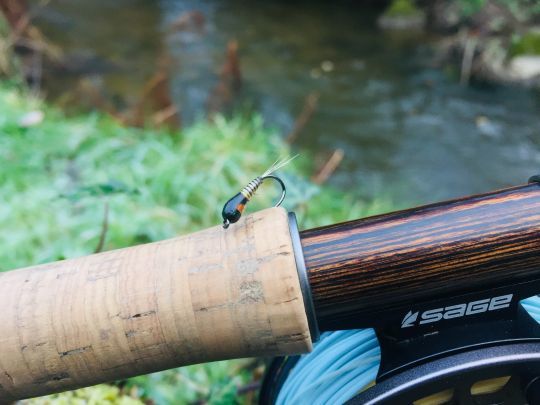
4- GV
A drowning machine named after its inventor. Hervé, known as Grand V because of his size. A friend, a Breton fly fisherman from Meslan (56) who is an excellent fly tyer and trout and salmon fisherman.
He offered me one several years ago. Rare local fisherman who opened his boxes to me.
He uses a sinker line on a 16° to 18° tip. It has enabled me to catch trout on various rivers in South Brittany, either on a point or a jib.
Assembly sheet
Hook Kamasan B170 size 10 or Daichi 1530 size 10.
UTC 70 mounting wire, black.
Come to the bend, then attach a few fibers of black rooster feathers (the base of the feather) or chicken feathers.
Form a small tail shorter than the shank. Then attach a piece of lateral scale shrimp pink.
Form an underbody in black mounting silk, then wrap the lateral scale over the entire body and lock it in place.
Take a small tuft of Grizzly marabou or olive sculpin and attach it to the top of the hook to form the wing. Attach a small Metz Grizzly rooster neck feather and make two turns. Form a small head with Uni-thread 8/0 wine silk. Apply a small drop of varnish to the head.
Tips and tricks
Works very well, especially in the slightly coloured waters of the early season and on overcast days.
The body emits iridescent midnight blue/purple reflections due to the scale lateral in pink transparency on the black body. One of the keys to this fly's success.
The marabou wing works on its own in the current and by animation in slower water.
It can be weighted with lead on the body, or with a ball in the head.
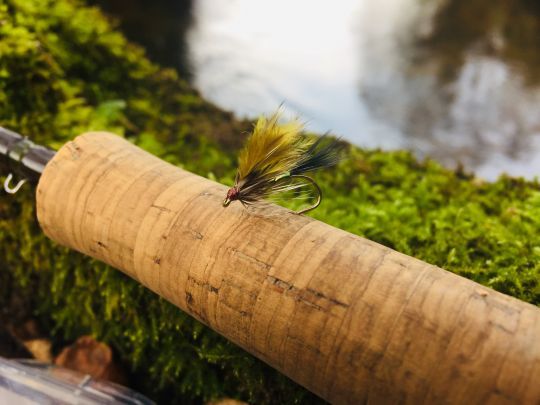
5- Zonker skull
In this period of high and cold water, I regularly fish with streamers. Here's a rabbit model of the famous zonker with a slightly different version that I've adapted to my needs.
It's helmeted for fast diving to the right depth. The rabbit gives it a very realistic swimming action, which is much appreciated and stabilizes it in the water. A great mouthful for the start of the season.
Assembly sheet
Partridge Predator trout hook size 6.
UTC 70 black mounting silk.
Come to the bend and attach some fine flashabou or angel hair gold fibers about 3 cm long.
At the hook point, attach the "natural brown" rabbit strip with a few turns of silk (and a small drop of glue). Form a chunky, tapered body with Spectra dubbing 335 (dark olive).
Fold the strip over and secure firmly. Trap some long hairs from the hare's back in a dubbing loop, then roll it up two times.
Position a Fish Skull small head and glue with a drop of cyano glue, then place the eyes with a drop of glue and cover with a thin layer of UV resin. Brush the body to remove a few fibers of dubbing spectra. Finished fly.
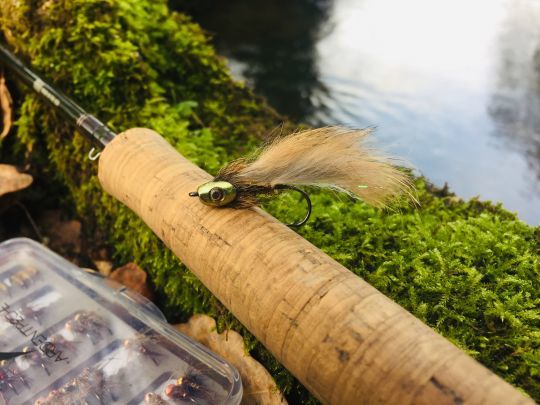
Tips and tricks
This streamer can be mounted in different rabbit colors. My favorite colors are brown, olive, sculping olive and black.
For lighter ballast, you can mount it with a brass ball, or heavier ballast with a 3 to 4 mm tungsten ball. Personally, I prefer the realistic sculpin heads.
The helmet allows it to go down quickly and be fishable right away. At the start of the season, let it drift ¾ downstream with very little movement. Then retrieve by knitting along the edge. On deep stations, don't hesitate to cast upstream to make it sink deeper while recovering the slack in the line before animating with slow pulls.
